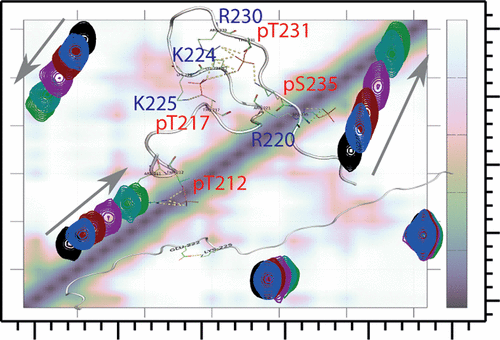

An increase in phosphorylation of the Tau protein is associated with Alzheimer’s disease (AD) progression through unclear molecular mechanisms. In general, phosphorylation modifies the interaction of intrinsically disordered proteins, such as Tau, with other proteins; however, elucidating the structural basis of this regulation mechanism remains challenging. The bridging integrator-1 gene is an AD genetic determinant whose gene product, BIN1, directly interacts with Tau. The proline-rich motif recognized within a Tau(210–240) peptide by the SH3 domain of BIN1 (BIN1 SH3) is defined as 216PTPP219, and this interaction is modulated by phosphorylation. Phosphorylation of T217 within the Tau(210–240) peptide led to a 6-fold reduction in the affinity, while single phosphorylation at either T212, T231, or S235 had no effect on the interaction. Nonetheless, combined phosphorylation of T231 and S235 led to a 3-fold reduction in the affinity, although these phosphorylations are not within the BIN1 SH3-bound region of the Tau peptide. Using nuclear magnetic resonance (NMR) spectroscopy, these phosphorylations were shown to affect the local secondary structure and dynamics of the Tau(210–240) peptide. Models of the (un)phosphorylated peptides were obtained from molecular dynamics (MD) simulation validated by experimental data and showed compaction of the phosphorylated peptide due to increased salt bridge formation. This dynamic folding might indirectly impact the BIN1 SH3 binding by a decreased accessibility of the binding site. Regulation of the binding might thus not only be due to local electrostatic or steric effects from phosphorylation but also to the modification of the conformational properties of Tau.
⏐ Published: May 11, 2023 ⏐ DOI: https://dx.doi.org/10.1021/acs.biochem.2c00717
